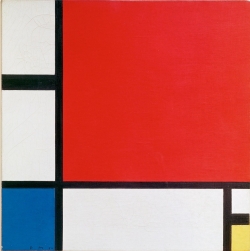 Piet Mondrian was born in 1872 in The Netherlands. He studied in Amsterdam from 1892 to 1895, and then began painting on his own. Most of his early works were landscapes. In 1909 he began a series of paintings of trees, in which he developed an increasingly abstract style. Piet Mondrian was born in 1872 in The Netherlands. He studied in Amsterdam from 1892 to 1895, and then began painting on his own. Most of his early works were landscapes. In 1909 he began a series of paintings of trees, in which he developed an increasingly abstract style. He moved to Paris in 1912, where he was influenced by the cubist painters. As the years went by, he began to formulate his own aesthetic theories. The style he developed he called neoplasticism. In the early 1900's, many artists were trying various abstract ways of representing reality. Mondrian went further ... in his later compositions, he avoided any suggestion of reproducing the real world. Instead, using horizontal and vertical black lines that outline blocks of pure white, red, blue or yellow, he expressed his conception of 'ultimate harmony and equilibrium'. These paintings are the ones for which Mondrian is best known. He said of his work, ‘If the paying public demands naturalistic art, then the artist can use his skills to produce such pictures - but these are to be clearly distinguished from the artist's own art'.Clearly he wasn't painting to sell to the public, but to satisfy his own inner feelings about what art should be. His later paintings, which date from 1920 until his death, have simple titles, such as ‘Composition in Red, Yellow and Blue’, painted in 1926, and ‘Composition in White, Black and Red’ (1936). He seemed to care little about public support, changing the style of his painting to a very abstract kind, almost purposefully ignoring what the public found pleasing. He started to paint pictures with overwhelming luminous colours. Some were very large ... one measured over ten metres wide! His works were admired by other artists, but did not sell. Eventually he moved to Paris, to learn from the man whom he considered to be the greatest painter of the age - Pablo Picasso. During the last years of his life, Mondrian lived in New York, where he became fascinated by jazz music; his paintings in his 'Boogie Woogie' series reflect this interest. His final painting, called ‘Victory Boogie Woogie’, was still unfinished when he died in New York City in 1944.
Broadway Boogie Woogie  Composition in Red Blue and Yellow |